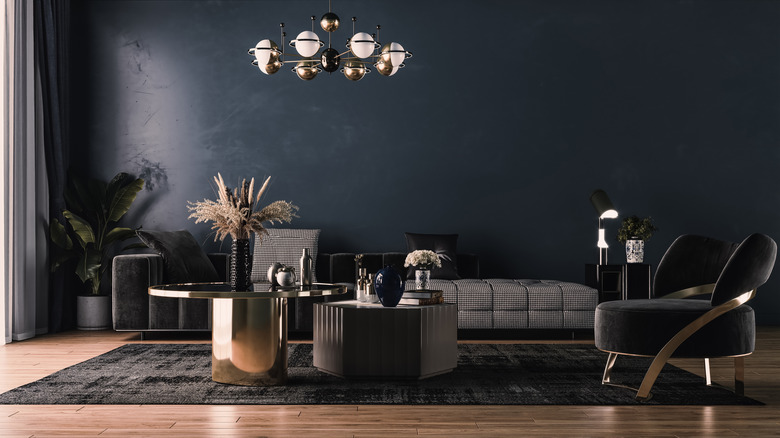The Paint Selection Mistake That'll Leave Your Room Feeling Darker
Picking the perfect shade of paint is quite the challenge, regardless of your level of interior decorating experience. There are hundreds — if not thousands — of color options, and even once you narrow your selections down to a general color family, you're faced with the most subtle nuances between shades. Add on the fact that you have to choose a finish, coordinate with existing décor, and still manage to apply several coats without making a mess, and it suddenly becomes a much more intimidating task than you'd assume at first glance. There's also a paint selection mistake that can make your life even harder: going with the first shade you select. You should always choose a color that's slightly lighter than your initial choice to reduce the chances of ending up with a final product you don't like.
Parting with the shade you finally settle on after hours of gauging subtle differences between colors seems like the opposite of a good idea, but it can actually make an ever-so-slight difference in the final product to ensure you're satisfied with your purchase. A shade or two lighter, in most cases, is just enough to tip opinion in the right direction.
Why to choose a lighter shade
When you're shopping for paint swatches in a hardware store, you're likely doing so in a massive room full of fluorescent lighting and reflective flooring. This means there's a ton of light bouncing around, making colors look lighter and brighter than they would otherwise. Once you bring these paint chips home, the same is true for your space — especially if you're painting over an existing light-colored wall. Light bounces off of lighter colors more than darker, and differences in time of day and sources of light can make color read differently.
"Remember that, when picking a color, go for a lighter shade," said co-founders of Waterleaf Interiors Jill Johnson and Suzanne Ascher in an interview with Apartment Therapy. "It always goes on darker than it looks." If your paint is still looking dark immediately after you apply, don't worry — you're likely in the clear. Once it dries down, it should transform into the perfect shade.
When this rule doesn't apply
In some situations, you don't need to go any lighter with your paint selections. It's a great rule of thumb when you're picking out medium-toned to pastel shades, but if you're intentionally going for moody and dark, you'll likely be just fine with your original choice. Additionally, if you're going to be painting a room that is consistently filled with bright or fluorescent light, the way the color reads in the hardware store will likely be fairly similar to how it reads on the wall at home.
While choosing a lighter shade is a helpful rule to keep in mind, the truth is that you likely won't know exactly how a color looks until it's on your wall. Instead of just buying and taping up paint chips, do your best to get a small, sample-sized tub of your final few colors, as they're usually only around $3 or $4 apiece. This way, you'll be able to see how they play off the light in your room across a larger space, and you'll likely have some leftovers in an easy-to-store container to touch up paint down the line.


